All the way back in the very first piece I mentioned the term “induced demand,” and how it shows the superficiality of the knowledge of the Traffic Troons. I was considering leaving it at that, but they use and abuse this term enough to put anyone into a homicidal rage, especially since they don’t appear to have ever heard of the economics terms “latent demand” or “elasticity of demand.”
Don’t take my word for it, look up “Induced Demand,” on YouTube and you’ll find an entire realm of snarky midwits ready to mindlessly repeat the same annoying garbage about how if you double the lanes on a highway then you’ll just get double the amount of people driving so it’s pointless to do that instead of shoving everyone on trains.
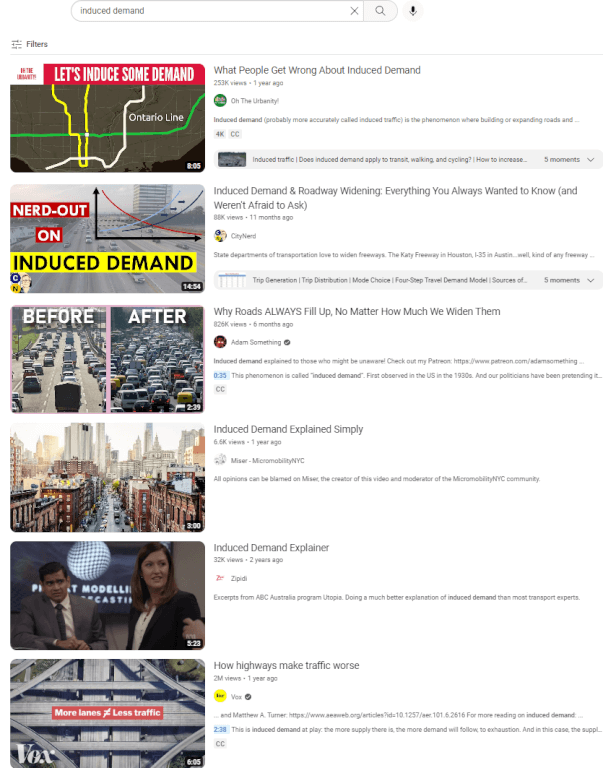
All of these videos are from these urbanite twats doing the same whine, even the two that you might have thought were doing otherwise are perpetuating the same tired garbage. And this is far from the last of it.
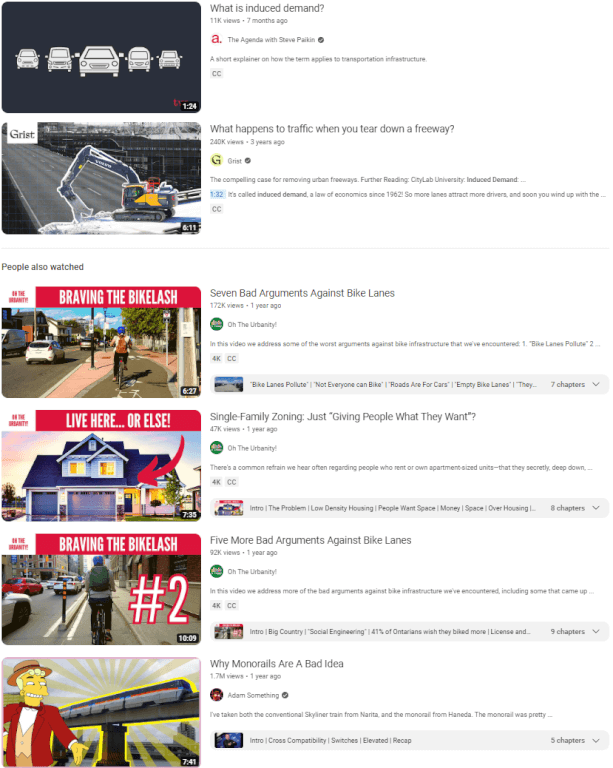
Here’s one of the videos that we’ll be covering in the next piece. Xir starts off whining about how much he fucking LOVES Science, unlike the filthy commoners. Then, one minute later, he just assumes that his hypothesis about always proportionally increasing “induced” demand is true with literally no evidence.
Ironic, but like I said, that’s for the next piece. In this one I explain what “latent demand,” is, by using an example.
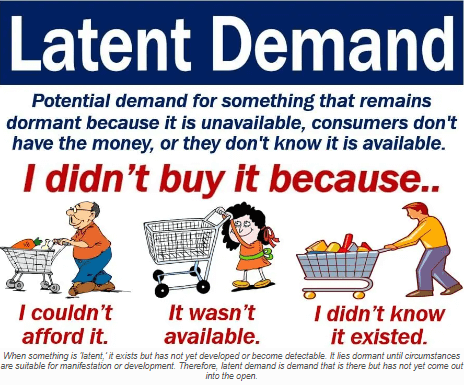
Let’s assume that we have a group of soldiers in a series of important tactical positions in a wooded area in the middle of a war. Our soldiers are in a variety of situations. Some of them are not engaged with the enemy, some of them are. In some areas they are more concentrated, in some areas less. Some areas are more built up, some less.
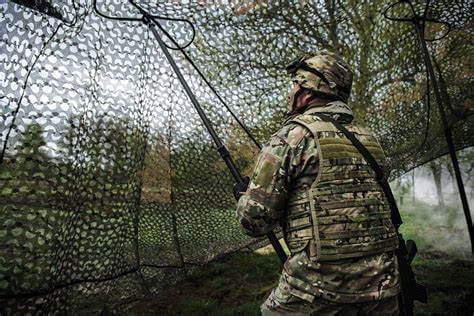
But the problem that they have is that any paved roads that might have supplied them are either too far away, or have been destroyed and are unusable. That leaves only some tiny dirt trails to supply them. Now, let’s even focus in on one very unfortunate group of guys. They are fighting the enemy, and have a desperate need of supplies. The only road they have is one tiny dirt strip that is only wide enough for one ATV and trailer to navigate it at any one time.

NOTE: This road is probably too narrow. Just imagine it slightly wider.
The narrow dirt trail looks like the trail above, albeit possibly a foot wider or so. The entire situation looks something like this.
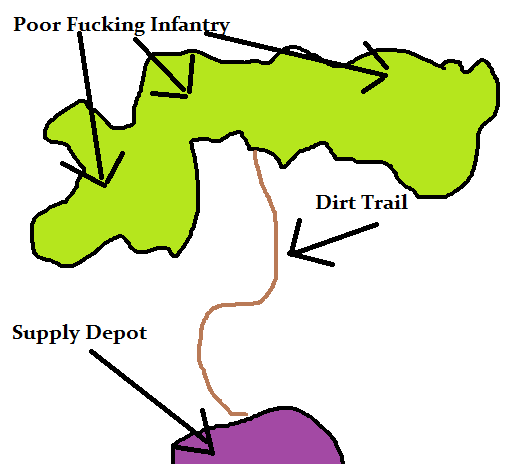
In the above image, the green is the area that our guys are in, the brown is the dirt trail the logistics crews have to navigate, and the purple is where the supplies are coming from. Everything in white is assumed to be impassable terrain, due to thick trees.
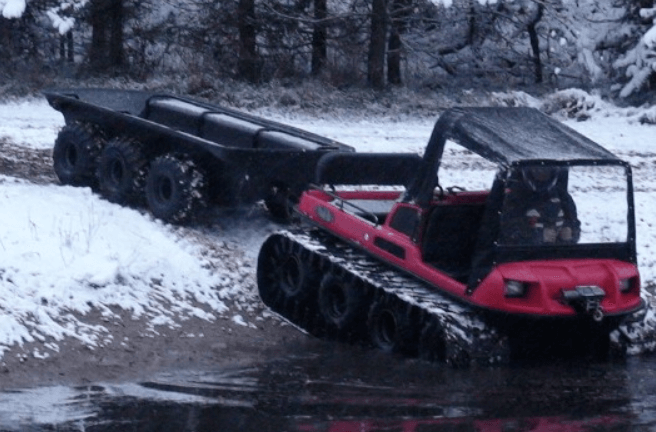
A representative of our tracked cargo ATV vehicle.
As a brief aside, those who have worked in logistics will have recognized another aspect to this problem, loading and unloading. If the loading area is infinitely large then we could send infinity trax into the area at whatever speed they can navigate the trail. They can be sent one after another, bumper to bumper, allowing us whatever throughput we can get from one continuous Trax, assuming we also have infinitely fast unloading and distribution speed.
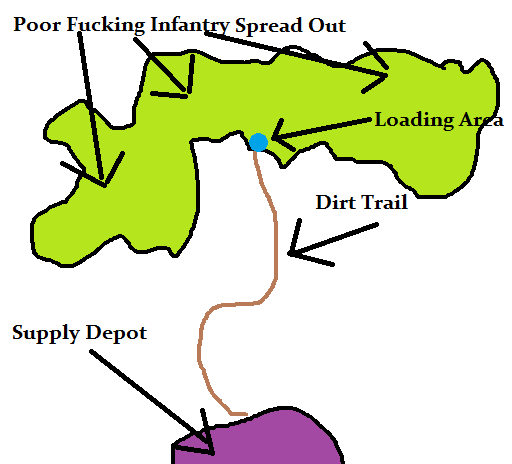
In order to make the problem even more clear I’ll assume that we only have space to unload one trax at a time, and that this is done in negligible time. There is absolutely no more space, perhaps for safety from incoming fire or geographical reasons, and won’t be until we change things. For now, every single trax we send has to go all the way there, unload, come all the way back, reload, and start all over again.
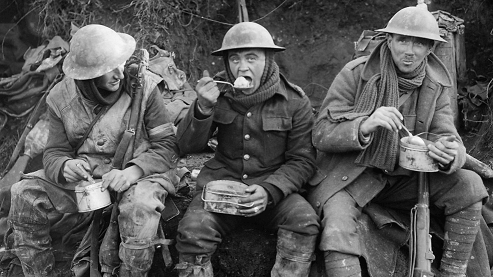
We have 5,000 soldiers trapped in this area. They can’t get out, and this is the only way to re-supply them. The Trax can make ten full trips per day, and holds 500 lbs per trip, for 5,000 lbs per day of supplies. Each of our soldiers requires 8 pounds of water and two pounds of food per day, for 10 lbs total. For 5,000 soldiers we need our Trax to supply 50,000 lbs of food. With the current road situation it can supply 5,000 lbs.

Either we need our soldiers to magically survive without food and water, or we need our road system to supply them better. The former seems unlikely, so we simply “twin” our single lane dirt road by adding another road made for one way traffic in the other direction. This is called:
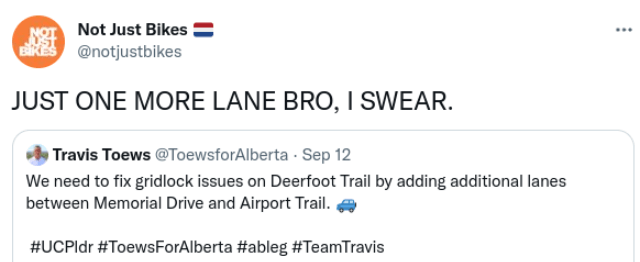
Yes, one more lane, bro. The armchair urbanists would laugh at us for this “idiocy,” our soldiers would be far more grateful. Luckily, we aren’t obsessed with being well-liked on Reddit, so we take the lives of our soldiers more seriously and add this extra lane for traffic in the other direction.
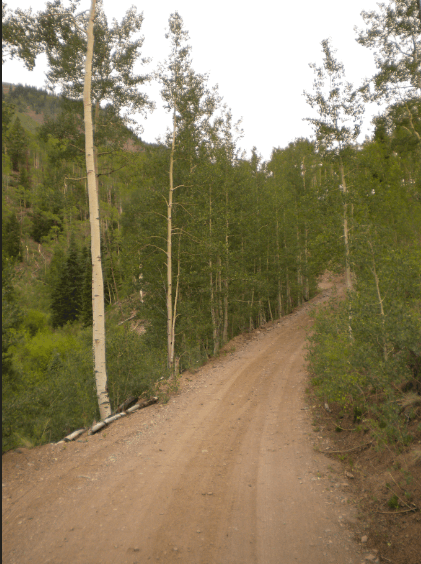
Once we have this, we can send Trax’s down to supply our troops as other Trax’s are returning. Our old throughput was the speed at which one Trax could make the round trip. Our new throughput is the rate at which a practical number of Trax’s can speed down the trail. Unfortunately we can’t send infinity Trax’s down the trail, even if loading and unloading was instantaneous, and we had an infinite number of them.
Let’s assume that a single Trax has an average speed through the rough trail area of 10 kmph. Slow, but steady. Put another Trax on the trail, separated by the entire length of the trail, and there will probably be close to zero slowdowns. But keep doing this and you’ll eventually run into serious practical limits.
The traffic shocks in this situation can be quite extreme, as sometimes the Trax’ get stuck in the mud, holding everyone up. In this case the military doesn’t care much about congestion, choosing to maximize transportation per road. Let’s say we’ve upped our Trax throughput from ten Trax-Trips per day with the single bidirectional path, to one hundred Trax-Trips/Day (TT/D).

Simplified speed/density curve from Road Guy Rob’s video.
Send too much traffic down an area and we risk getting less total transportation due to constant traffic jams. Think highway congestion when there start being too many cars and everyone has to slow down to a crawl, versus somewhat less cars at disproportionally higher speeds.
Since we’re trying to maximize transportation we can take somewhat lower average speeds/Trax due to intermittent congestion. Let’s say that we throw 20 Trax’s at the problem, at 5 TT/D each, with any more counterproductive. This should be more than enough, right?
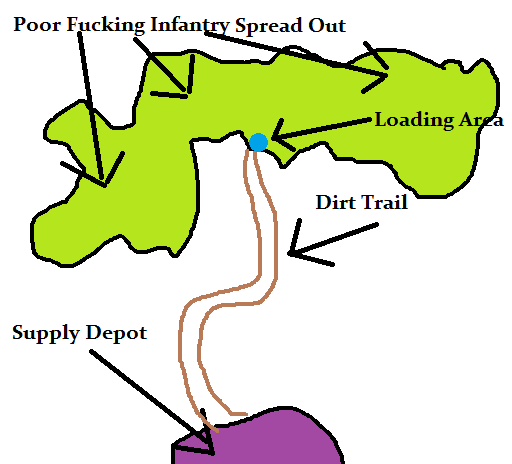
Yes. We have 50,000 lbs of supply, and our soldiers needed 50,000 lbs of supply. We have perfectly satisfied the latent demand of our soldiers. Problems solved.
Except, problem not solved, because we don’t just have soldiers so that they can eat food and drink water, we have them so they can win wars, and that requires ammunition. And we didn’t really satisfy the latent demand for goods and therefore road capacity.

Mortar bombs aren’t exactly weightless, and neither are cartridges. We’ve managed to get our soldiers to not die in the absence of the enemy, but let’s say that they spend an average of 10 lbs/day on ammunition. This is probably underselling it, seeing that a three man mortar team can chew through hundreds of lbs of mortar bombs per minute, we’re probably underselling things, but let’s just say it’s only 10 lbs/day.
This pushes our cumulative supply needs to 100,000 lbs/day. We’re currently at 50,000 lbs. If only there was some way to double the capacity. Can anyone help me with this? I can’t think of anything, and I’m desperate for suggestions.

Wow, thanks Jason!
We take our little dirt road and add another lane both ways. We could also make a new two lane road in a somewhat separate location, the results would be functionally identical in this example. In real life there are pros and cons to widening roads versus building new ones, but we’ll assume for now that we add another lane in each direction, because it’s fun to more directly contradict the “muh one more lane,” snarky pseudo-intellectualism.
I couldn’t hope to actually draw this, but we have increased our road capacity by double the amount. We now have 100,000 lbs of road capacity, as measured in terms of goods shipped, and our soldiers are finally able to not just die of dehydration or starvation, but actually fight the enemy.

Before we go any further, let’s take a minute and compare our military, which we will call the Eebil Natzee Road Enjoyers, versus an opposing military, who we will call the Reddit Urbanite Geniuses. In our military we built our soldiers the roads and road capacity that they needed to survive and have a constant supply of ammunition. The (P)Redditors were far too smart to do that. They understand that building more roads and lanes is stupid because the capacity gets used up, so they stuck with the one lane, bidirectional trail. In fact, if they were to see our road expansions they would laugh, because all of that road capacity got used up, and congestion was even worse.
Here is a highly intelligent meme they made explaining this situation.

These Redditors are extremely smart. Far, far more intelligent than you or I. Unfortunately for them, our military will now absolutely destroy their military, since our soldiers have food, water, and ammunition, while theirs could literally be beaten just by our guys doing nothing and waiting for them to starve to death or die of dehydration.
Turns out, the purpose of roads is not to never have their capacity used up. The purpose of roads is to transport stuff. Satisfying latent demand is not dumb, it is what you do if you aren’t a complete and utter moron.

Our military would probably destroy them if the situation was reversed. These are Predditors after all. But I hope this example served as a clear explanation of latent demand. If you build more roads and those roads got filled with traffic to maximum capacity, that means that you should have built even more roads, not that building the roads were dumb.
We could also flip this around, and imagine the military building roads in the middle of nowhere. If we have a trail on a random wooded hilly area, and we start expanding the road network just like we did in the conflict area, what would happen?
Nothing, since there’s no one there. The tiny little trail was already satisfying the tiny or non-existent amount of traffic. Building more roads did not magically create “induced demand” for people to fill up the road capacity, because “induced demand,” is just another form of latent demand. Empty areas don’t have transportation demands, and will have zero “induced demand.” That’s why these trails below aren’t magically full up with people who spawned into the gameserver. And if you built ten more trails right beside them they still wouldn’t be full.
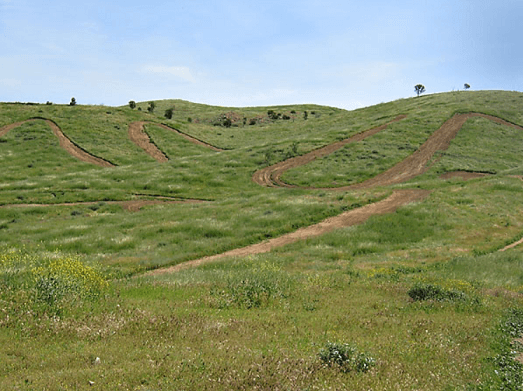
There is necessary latent demand, with starving soldiers being a great example. There is non-existent latent demand, with no one living in areas that have plenty of roads. And then there is everything in between.
Let’s continue our high-conflict area example to better understand the variability of induced demand. We can assume, with the vehicles we have at our disposal and the soldiers in the situations that they’re in, that we need a certain amount of road capacity to keep our soldiers alive, and then another amount to keep them with the ammunition they need to fight. This turned out to be two lanes each way for every 10,000 soldiers.
But this is just enough for that exact number of soldiers to be effective in the short term, with zero road capacity left over for anything else. The problem is, we talk to our soldiers, and we find that they want road capacity for a variety of things. Rather than snarking that they don’t understand induced demand we do what the soldiers want. And you know what they want?
That’s right, we build a train in a random part of the wilderness. Just kidding, that’s retarded. Instead we build one more lane, bro. This brings our dirt strip “highway” to six lanes in total. But the soldiers keep saying they want more road capacity, so let’s go ahead and add another lane each way, for 8 lanes total. But what are we going to use this extra capacity for?
Our soldiers keep telling us that they really like to outnumber the enemy. Something about huge tactical advantages to more numbers. But we previously couldn’t keep any more troops properly supplied. In fact we didn’t even have the road capacity to send more troops in there in the first place, since that would cut into the supplies for the existing troops. But, wait a minute, turns out that with our doubled road capacity we can support double the troops in our location, so we go ahead and use up the “excess” road capacity to double our numbers to 20,000 troops.
Let’s also say that our Reddit Troon Brigade this time around wasn’t so ridiculous that they just let their soldiers die, or fight without ammunition. That was a bit too much even for them, so they built a four lane road, two each way, and there are enough supplies to support their 10,000 troops. They see us building our 8 lane road, and they chuckle to themselves. See, they were really smart, so they understood that two lanes each way was all that was “needed.” After that we “suffered” from “induced demand.” If we hadn’t built the roads, we wouldn’t have even bothered sending in twice the troops.
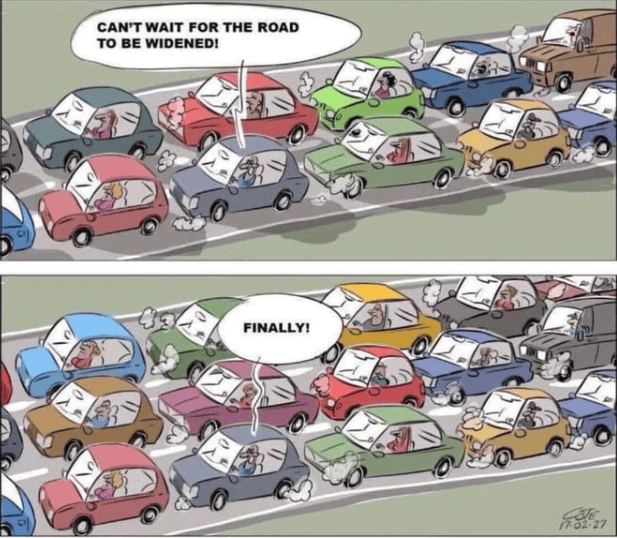
Another genius meme by the Nintendo Switch connoisseurs.
You might not understand how OWNED we the dumb Eebil Natzee Road Enjoyers just were. You’re probably thinking that it’s a good thing that the extra road capacity we built was used in order to outnumber the enemy. But what you would know, if you were smart, is that the extra roads we built were entirely used up to full capacity, therefore congestion didn’t improve. What this means is that the new road lanes simply “induced demand.” Induced demand is bad, because reasons. Therefore, there was no advantage that we gained from doing this.
Anyway, we then launch an attack outnumbering them 2:1. We can do this because we built enough lanes to support this amount of troops. We slaughter them all.

Redditors are dying!
Above is a decent example of induced demand, although it can be misleading, since in this case there is such an enormous latent demand that we can always use very close to 100% of the seemingly excess road capacity. This is very similar to suffering with a computer that has a tiny amount of storage capacity, something like 8 GBs. Every little bit extra brings us tremendous benefit.
But increasing road capacity, just like increasing storage capacity, has diminishing marginal returns. If we already have a computer with an enormous amount of storage, we may well never come close to filling it. If we have an area that has low population and plenty of road access, we may get zero benefit from increasing road capacity. Where it gets interesting is right in between.
Imagine that, instead of 20,000 troops in the area, we have just 1,000 troops, or 5%. One of two extremes could happen. First, we could find the troops only using 1/20th of the road capacity. That would mean that we have a fixed amount of roads that we want per soldier, just enough for food, water, and ammunition in this case. Second, they might be constantly using all the available road capacity and demanding more.
The things they want the roads for are numerous. If Canadian winter is coming then they’ll need coats and other material trucked to them. They want better fortifications, which may a few or many hundreds of tonnes of materials brought in as well as tools.

They want a network of small roads built in their area, so they can move themselves and goods around faster, requiring tools and perhaps gravel. They want more unloading areas built, so they don’t have to lug the heavy goods to the final destination by hand. And of course, the more roads we build, the faster we can move troops in and out of the area for reinforcement or retreats.

What it might look like, even with 1,000 troops.
The exact rate of road utilization for this imaginary situation is not that interesting to me. Only that it’s reasonable that they would be using proportionally far more road/soldier than when this same area was filled with 20,000 soldiers and we had barely enough trucking to keep them alive.

The urbanites would look at this and go “aha! You see building the additional roads was pointless because they sometimes filled up. You just didn’t understand that the there was induced demand from the excess road capacity.” Except that the additional roads let us build things like this instead of being used purely for subsistence. “Induced demand,” simply means additional productive uses for the roads. I can’t stress this point enough.

But there’s no doubt that, drop our soldier count low enough, and we will soon stop using our roads to their maximum capacity. This is because there is no such thing as infinite demand. It’s possible that 1,000 soldiers would saturate 8 lanes of dirt road, but would 100? Would 10? Would 1? There comes a point where the area is simply so sparsely populated that you cannot possibly find ways to fully utilize a robust road network.
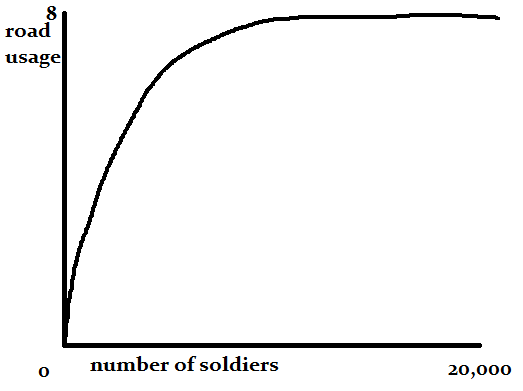
Average road usage by lanes filled to capacity.
As the number of soldiers goes down, their average use of the roads goes up, but not necessarily proportional to the decrease in soldiers. There is naturally more demand for road transport the more troops there are in an area.

Here’s another way to look at it. The fixed, non-negotiable demand increases proportionally to the number of soldiers in an area. That’s the red and the yellow. However, as we decrease the number of soldiers for the same road capacity, they can start utilizing the road for other productive enterprises, at least some of the time.

Eventually there’s not enough of them to maximize the road usage. For an extreme example of this, imagine a ten lane superhighway going from one tiny town to another. It would be a ghost highway because we can’t just magic up demand from nowhere.
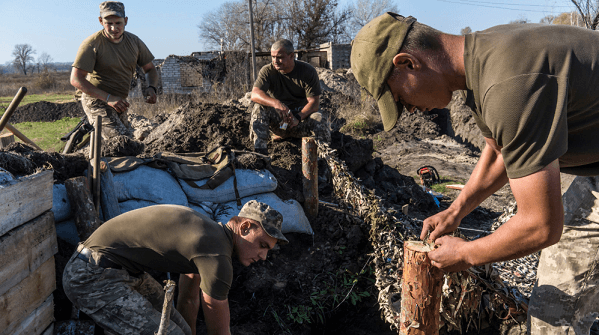
If we went and built “just one more lane bro,” in the areas that are not seeing any conflict, we will get zero, or close to zero additional road usage. We do not magically “induce demand,” for our generals to randomly send troops, supplies, and raw material to random areas on the map. If we go in and build “just one more lane bro,” in the area with extreme conflict, we will see close to full road capacity usage as we satisfy the much higher latent demand. When in between, we get something in between.

Let’s give another example that’s even easier to understand, troop transport helicopters. We’ll pretend that they were just invented, and our military, the Eebil Natzee Road Enjoyers, just got our hands on them. As of now, we don’t plan our missions or military around them at all. The only thing that we use our one and only helicopter for is getting soldiers out of hot areas where land transport can’t get there in time, or can’t get there are all. The alternative in almost every case is our troops being encircled and either killed or captured.
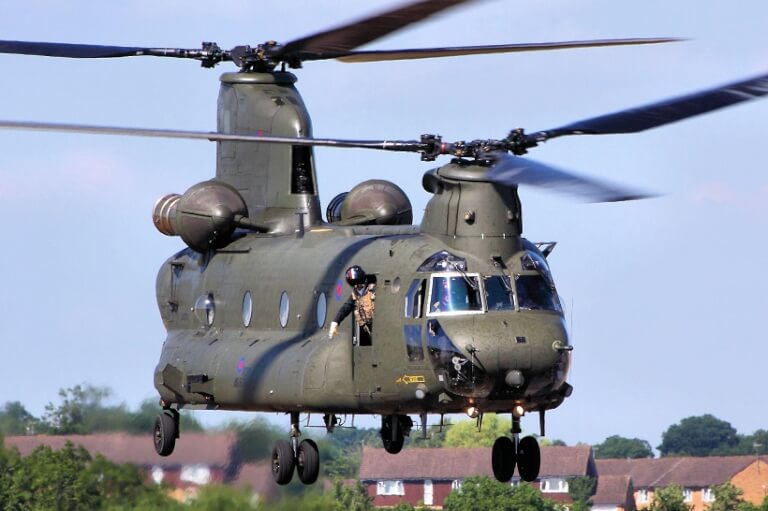
We find that this service is extraordinarily useful. It is extremely rare that we don’t have troops that need this service, and at any given moment we could use an average of 5x as many helis as we have. In some very rare and unfortunate cases we could use 100x more helis, but every now and then there isn’t anyone to pick up this way, so the heli is used at 97% capacity, except when in maintenance.
NOTE: We’re ignoring a lot of factors such as maintenance to simplify this example.
Let’s pretend that money, pilots, tarmac space, you name it, it’s all no object, and we go ahead and build 99 more helis, which fits our peak demand. These will not have 97% utilization rates like our first heli. They will have 5% average utilization rates, which does appear to be wasteful. Except… what if we start using them for different missions?

Hold that thought, because it’s time to compare the Eebil Natzee Helicopter Enjoyers with the Reddit Urbanite Brigade. The Reddit Troons started with one troop transport heli, just like us. They found it just as useful initially as we did. However, they then “logicked” that building more helis would be bad, since the additional helis would be used. No amount of extra helicopters would change this, so more is bad.

They have a little catchphrase for this.
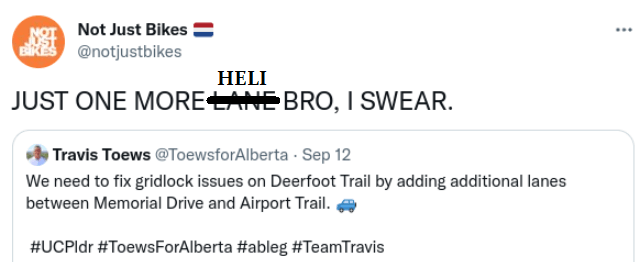
Because you see they understand something that you do not, which is that our 100 helicopters are actually still not enough. An enterprising General noticed that we can start using our helicopters for additional missions. Instead of waiting for soldiers to get trapped in terrible spots and need evac, what if we planned missions around using the helicopter?
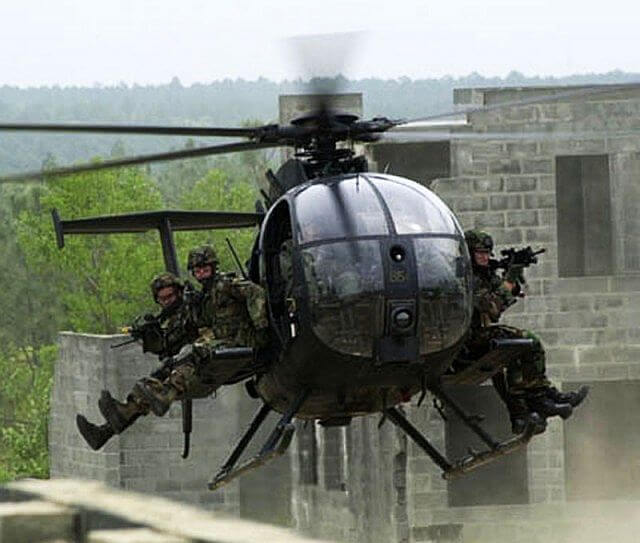
We start planning missions to use heli transport to and fro an area, or even just planned pickups by heli. It’s not always perfect, but we find that a lot of good work gets done this way. Additionally, our infantry learn to take more potentially rewarding risks, since they can now count on heli evac bailing them out when things go south. We’ve even found some niche uses like air dropping small supplies.
Our fleet of 100 birds don’t actually have a 5% average utilization, they have a 20% average utilization, due to this “induced demand.” And did you hear that term, induced demand? That’s really bad, because reasons. You might think it’s good that our military can do fundamentally different missions with planned air transport, that our ground forces have more reliable extraction, occasional air supply, or what have you. We increased our fleet size by 100x, but that caused an increase in our demand of 4x. The “induced demand,” increase was not proportional to our increase in capacity, but it was there.
As a regrettable downside we’ve gotten so used to planning missions around helicopters that more and more troops do find themselves stranded by helis, as hinted at before. In the worst case scenario we had the need for 200 helicopters, but we only had 100, satisfying half the peak demand. All told, this seems like a good deal. But that’s just your dumb normie brain giving yourself away. It was far smarter to have not built any additional helicopters.
Temember, expanding road transport capacity is dumb, because the purpose of roads is to have no one ever use them. Likewise, expanding heli transport is also bad. The purpose of more helicopters is not to transport more people. The purpose of more helicopters is to have them sit on the ground doing nothing, or flying with fewer troops inside of them each time, to make sure that at peak traffic times we always have enough of them.

This is exactly the same “logic” they use to argue against building more roads and lanes. Because their additional helis would be used, they never made them. I know that sounds too dumb to believe, but to interpret their arguments in any other way would be to read something in there that just doesn’t exist. Because the additional road capacity is used, it is bad. Because the additional heli capacity is used, it is bad.

Induced demand is good, because satisfying demand is good. Helicopters being used in their original role, picking up stranded troops where land transports can’t reach, is good. Making more of them to fulfill this role, provided we don’t wastefully build too many, is also good, but we will find that they get lower and lower utilization rates. Making use of these helis sitting on the tarmac to do new types of missions is also good.

But again, there is a limit to demand in reality. The first few missions we can do this way are probably the most useful, picking the low hanging fruit so to speak. What happens if we expand our heli fleet to 1,000? What about 10,000? Is there infinite latent demand for troop transport by helicopter? Obviously not. There are diminishing marginal returns in real life, and induced demand is never proportional.

Here’s one last example of this before I end this piece: hard drive storage. You’re probably reading this on a machine that has an SSD, but let’s ignore that for now, because streaming speeds are irrelevant for the purpose of this conversation, only disc space.

You may have had the experience of running out of storage on your computer, phone, or other device. I certainly have, and I’ve wished more than one time for more SSD space. In fact, here’s mine right now.

You might think that more hard drive space would solve your problem. You might think that you have x amount of stuff you want on your computer, which requires at least x amount of space.

But you’d be wrong. Because you see, if we give you more hard drive space, you will simply use it all up. Why’s that you ask? Well because of induced demand. You see, I am a genius, who understands what you don’t, which is that different hard drive space amounts change user behaviour. If you have more space, you will be less frugal with your storage, and more likely to put random garbage on there. How much less frugal? Well, proportionally less frugal compared to the increase in storage size. It definitely can’t be that you’d be 5% less frugal, and 95% just enjoy more storage. No, for reasons that I will never explain, it must be 100% frugality change.
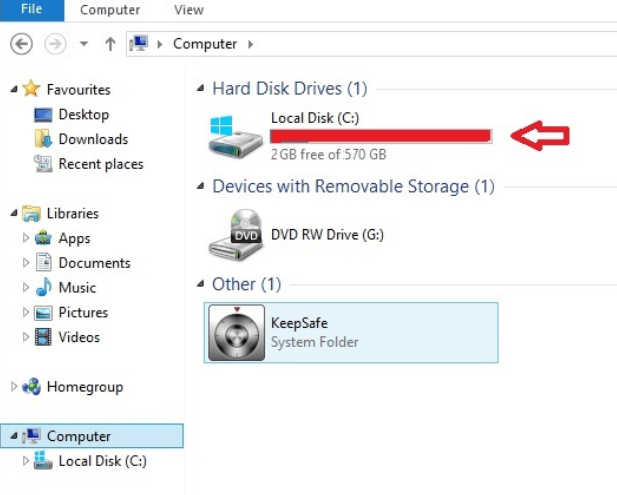
Above we see a 570 GB hard drive with only 2 GBs of space remaining. Below we see a hard drive less than half the size with 2.54 GBs of space remaining. So a smaller drive, but with more remaining space?
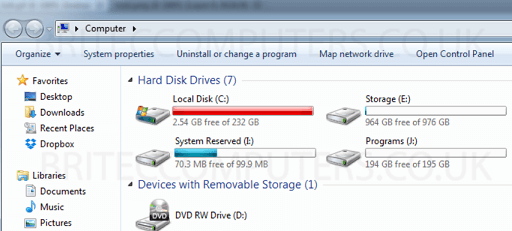 What this proves beyond a shadow of a doubt is that hard drive space is irrelevant. We can go from 512 GB’s down to 256 GB’s, with no issues. Similarly we could go from 512 GB’s up to 1 TB of data, and you’d still fill it up. And why stop there. We could give you a 1 PetaByte SSD, you’d still fill it up. In the other direction, we could give you a 1 GB hard drive, and you’d be totally fine. Because induced demand, and global warming. You’re dumb if you don’t agree.
What this proves beyond a shadow of a doubt is that hard drive space is irrelevant. We can go from 512 GB’s down to 256 GB’s, with no issues. Similarly we could go from 512 GB’s up to 1 TB of data, and you’d still fill it up. And why stop there. We could give you a 1 PetaByte SSD, you’d still fill it up. In the other direction, we could give you a 1 GB hard drive, and you’d be totally fine. Because induced demand, and global warming. You’re dumb if you don’t agree.

We here in the Urbanist Tranny Community have a term for this.
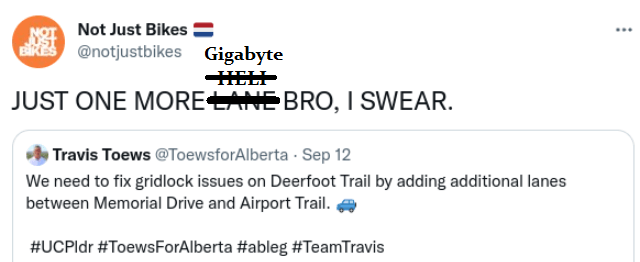
Imagine not understanding how a hard drive with a 16 megabytes of data is just as good as one with 16 terabytes. Imagine not understanding induced demand.












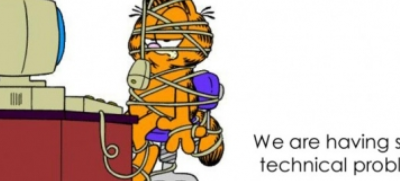

I see these “anti-car” arguments as only one thing: a veiled attempt to justify lowering living standards. Or to use your analogy, to justify losing the war.
In a real situation, their “let’s lose the war so that we don’t disturb the forest’s natural aesthetics” would get them court-martialed, or cashiered. But, alas, losing wars seems to be a key clown world feature.
Pretty much. They all have ulterior motives, something that you can pick up on with just a brief exposure to them.
[…] PSA: Deboonking the Traffic Soyboys Part 11 – “Induced Demand” is not “Propo… […]
“ instead of shoving everyone on trains.”
Hey, I don’t think we should shove everyone on to trains, but these soy boys could certainly be shoved on to some trains, if you know what I mean. 😎
They could take these trains to camp, where they could learn to concentrate on not being such faggots 😁
Hear hear.
kek
but if the roads are clogged up with gridlock why would anyone take my rape train?